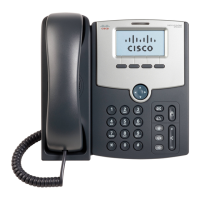Provisioning Basics
Redundant Provisioning Servers
Cisco SPA 500 Series and WIP310 IP Phone Administration Guide 140
6
• Port defaults to:
- 69 for TFTP
- 80 for HTTP
- 443 for HTTPS
• Profile-path defaults to the path to the new resync profile (for example,
http://192.168.2.217admin/resync?tftp://192.168.2.251/spaconf.cfg).
Rebooting a Phone
You can remotely reboot a Cisco IP phone if needed.
Use the following syntax to reboot a phone:
http://phone-ip-address/admin/reboot
Redundant Provisioning Servers
The provisioning server may be specified as an IP address or as a fully qualified
domain name (FQDN). The use of a FQDN facilitates the deployment of redundant
provisioning servers. When the provisioning server is identified through a FQDN,
the Cisco IP phone attempts to resolve the FQDN to an IP address through DNS.
Only DNS A-records are supported for provisioning; DNS SRV address resolution
is not available for provisioning. The Cisco IP phone continues to process A-
records until the first server responds. If no server associated with the A-records
responds, the Cisco IP phone logs an error to the syslog server.
Retail Provisioning
The Cisco IP phone includes an web UI that displays internal configuration and
accepts new configuration parameter values. The server also accepts a special
URL command syntax for performing remote profile resync and firmware upgrade
operations.

